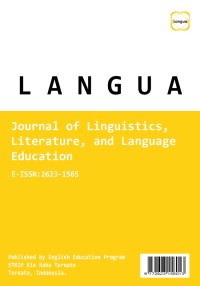The Structure of Peer Feedback
A Proposal to a Systematic Peer-Feedback Implementation
Abstract
This article aims to propose an overview of structured peer-feedback applications. Even though peer-feedback is no longer a new thing in the world of teaching writing, until now there are still many researchers who are interested in studying it and not a few teachers are still using it. Research that has been conducted to test the effectiveness of peer-feedback and student responses to peer-feedback activities still shows different results. One thing that needs to be considered important is that differences in the results of peer-feedback use and research may result from unstructured application of peer-feedback. Experts have indicated that peer-feedback can be applied flexibly. They imply that peer-feedback activity should not be restrained in a rigid system. However, research suggests that without careful preparation, peer-feedback activity is unlikely to produce satisfactory results. In order for peer-feedback activity to be prepared, special stages in implementing peer-feedback cannot be avoided. Meanwhile, we are faced with the fact that until now there is no system that regulates the peer-feedback structure. It is for this reason that this article was written. Using literature research, this article provides a peer-feedback structure worthy of attention.
Downloads
References
Clark, I. L. (2003). Concepts in Composition: Theory and Practice in the Teaching of Writing. Lawrence Erlbaum Associates Publishers.
Fatimah & Masduqi, H. (2017). Research Trends in EFL Writing in Indonesia: Where art thou? Journal of Teaching and Education, 7(1), 89-98.
Harmer, J. (2007). How to Teach Writing. Longman.
Hong, F. (2006). Students’ Perception of Peer Response Activity in English Writing Instruction. CELEA, 29(4).
Hyland, K. and Hyland, F. (2006). Second Language Writing. Cambridge University Press.
Ion, G., Barrera-Corominas, A., and Tomas-Folch, M. (2016). Written Peer-Feedback to Enhance Students’ Current and Future Learning. International Journal of Educational Technology in Higher Education, 13(15), 1-11, DOI 10.1186/s41239-016-0017-y.
Kusumaningrum, S. R. et al (2019). The Effect of Different Types of Peer Feedback on EFL Students’ Writing Performance. International Journal of Instruction, 12(1), online first.
Lim, S. C., and Renandya, W. A. (2020). Efficacy of Written Corrective Feedback in Writing Instruction: A Meta-Analysis. TESL-EJ, 24(3), 1-26.
Manser, M. H. (2006). Guide to Good Writing. Fact On File, Inc.
Montague, N. (1995). The Process Oriented Approach to Teaching Writing to Second Language Learners. New York State Association for Bilingual Education Journal, 10, pp.13-24.
Patthey-Chaves, G. G., Matsumura, L. S., and Valdes, R. (2004). Investigating the Process Approach to Writing Instruction in Urban Middle Schools. Journal of Adolescent & Adult Literacy, 47(6), 462-477.
Pham, T. N. et al (2020) Electronic Peer Feedback, EFL Academic Writing and Reflective Thinking: Evidence from a Confucian Context. SAGE Open, 2020 1-20 https://journals.sagepub.com/doi/10.1177/2158244020914554.
Rismawati, S. R. A. (2018). Feedback Given by the Teacher on Students’ Writing at the Seventh Grade of SMP Negeri 2 Juwiring. Unpublished Thesis in the Muhammadiyah University of Surakarta.
Singh, R. K. and De Sarkar, M. (1994). Interactional Process Approach to Teach Writing. English Teaching Forum, October 1994, 18-23.
Spear, K. (1988). Sharing Writing: Peer Response Groups in English Classes. Boynton/Cook Publisher.
Tehrani, F. A. (2018). Feedback for Writing or Writing for Feedback? Journal of Language and Linguistic Studies, 14(4), 162-178.
Thomas, M. (2005). The Oxford Guide to Library Research. Oxford University Press.
Williams, J. (2005). Teaching Writing in Second and Foreign Language Classrooms. MCGraw Hill.
Zainurrahman (2010). Peer Feedback: Students’ Narrative Writing Development and Students’ Responses. Unpublished Thesis in the Education University of Indonesia.
Zainurrahman (2011). Menulis: dari Teori hingga Praktik. Alfabeta.
Zemach, D. E. and Rumisek, L. A. (2005). Academic Writing: From Paragraph to Essay. MacMillan.
Copyright (c) 2021 Z Zainurrahman

This work is licensed under a Creative Commons Attribution 4.0 International License.
Authors who publish with Langua Journal of Linguistics, Literature, and Language Education agree to the following terms:
- Authors retain copyright and grant the journal right of first publication with the work simultaneously licensed under a Creative Commons Attribution License that allows others to share the work with an acknowledgement of the work's authorship and initial publication in Langua.
- Authors are able to enter into separate, additional contractual arrangements for the non-exclusive distribution of the journal's published version of the work (e.g., post it to an institutional repository or publish it in a book), with an acknowledgement of its initial publication in Langua.
- Authors are permitted and encouraged to post their work online (e.g., in institutional repositories or on their website) prior to and during the submission process, as it can lead to productive exchanges, as well as earlier and greater citation of published work.






